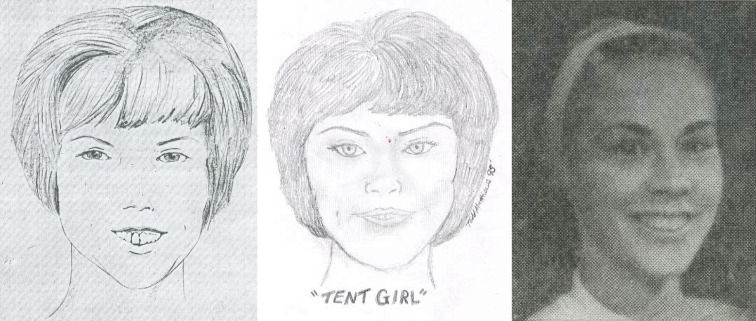
How the Case of the Dead "Tent Girl" Was Solved by Internet Detectives
March 16, 2021Otherwise known as armchair detectives or internet detectives, these people spend their time investigating grim cold cases that the "professionals" failed to solve. When the police are powerless, amateurs and the Internet take the lead.
1967
Wilbur Riddle was an ordinary worker. He worked most of his life digging wells. And on that evening in May 1968, he probably would have preferred to dig another well rather than discover what he found walking along Route 25 near Georgetown, Kentucky. Riddle stumbled. Looking down, he saw an elongated parcel wrapped in a hard black canvas – the sort usually made for tents.
He nudged the bundle with his foot, and it rolled downward, unwrapping as it went. He immediately called the Sheriff from the nearest station. When the police unrolled the remainder of the canvas, they saw the girl's body. Unable to discover her identity, police named the woman "Tent Girl," thanks to the canvas she was wrapped in.

Forensic experts examined the body. The dead girl was only 5 foot 1 inch tall and weighed no more than 110 pounds. She had reddish-brown hair, manicured nails, and gaps between her front teeth. The police were soon contacted by the mother of 15-year old Doris Dittmar, who suspected that they had found the body of her missing daughter.
The description of the Tent Girl matched the information provided by Doris's mother. But just before the police were about to hand over the body to be buried, Doris Dittmar was found alive and well.
It turned out that the young woman had simply run away from home with her boyfriend to stop her mother from interfering with her personal life.
The Tent Girl remained unidentified for years.
The coroner established that the girl was indeed killed. But more information could not be obtained: no leads, no evidence. Today, DNA analysis could help. However, in those days, this technology was not available.
After three years of investigation, no family came forward to claim Tent Girl. So, in 1971, the girl was buried in Georgetown. The headstone was donated by the city and, instead of a photograph, included the police sketch of her face in an attempt to restore her appearance. Age, date of death, etc., were all approximate figures.

Halloween, 1987
At a Halloween party in 1987, Wilbur Riddle's daughter Lori Riddle told the story of her father discovering the body over twenty years prior to her boyfriend, 17-year old Todd Matthews. He was immediately taken in by the unsolved case and even questioned Riddle himself about the incident.
It was not entirely clear why this story had such an effect on Mathews, but he soon became determined to look into this matter. Only a few years later, Mathews and Lori got married, allowing Mathews to investigate the case together with his father-in-law.
Creating a Website, 1997
The first task was to establish the identity of the girl.
Mathews spent the first few years of his search following paper trails and tracking down people from the original investigation. When the internet started to become available in the mid-1990s, his investigation took a new turn. Mathews switched his focus to the amateur detectives (aka armchair detectives) – internet sleuths that flooded message boards dedicated to solving cold cases on the web.
In November 1997, Mathews himself started his own website, Tentgirl.com. By creating a dedicated website, he hoped that the young woman's family would stumble upon the site and contact him. But when no new leads appeared, he returned to the message boards.
Exhumation, 1998
In January 1998, Matthews unexpectedly came across a classified listing from a woman in Arkansas named Rosemary Westbrook. The woman was looking for her sister, who disappeared in 1967: height 156 cm, brown-haired woman, brown eyes. The Tent Girl matched this description, and the picture of her sister Rosemary resembled the police sketch.

In March 1998, Rosemary and Matthews joined forces and got permission for the Tent's Girl's exhumation. Years had passed, and by now, it was possible to count on the fact that DNA analysis would uncover more information than 30 years before. And as expected, DNA analysis of the body confirmed that the Tent Girl was a close relative of Rosemary Westbrook.
Tent Girl was from then onwards Barbara Ann Hackmann, Rosemary Westbrook's sister. She was only 24 years old when she died.
Barbara's Story
In 1967, Barbara lived in Lexington, near where her body was found, with her husband, George Taylor, and their young daughter. Despite working as a waitress at a local restaurant, her mother and father were convinced that she lived in Florida. This meant that the news of the unknown murdered somewhere in Kentucky hadn't bothered them.
When Barbara disappeared, her husband said that his wife left him for another man. He stood by this lie until dying from cancer in 1987. Although there's no evidence that he killed her, it's highly likely that he played a part in her death.
He told people that Barbara had run away with another man after returning home from work with only his daughter and not his wife. But according to eyewitnesses, Taylor had a hard temper and an explosive disposition. He was viewed as controlling, jealous and always took Barbara with him. Plus, he was a carnival worker and would have had easy access to the type of canvas her body was found in.
Since her body has been identified, her real name has been carved on the headstone – Barbara Ann Hackmann.
